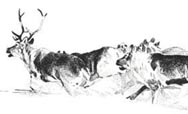 Manitoba is the home to as many as 20 woodland caribou herds. The Manitoba government has determined the geographic ranges, calving sites and winter ranges for these herds, plus the current degree of risk for each herd in a range. Every environmental license area for forestry operations in Manitoba includes specific woodland caribou ranges. Woodland caribou are listed as endangered by COSEWIC through eastern Canada, and are listed as threatened in Manitoba. Manitoba is the home to as many as 20 woodland caribou herds. The Manitoba government has determined the geographic ranges, calving sites and winter ranges for these herds, plus the current degree of risk for each herd in a range. Every environmental license area for forestry operations in Manitoba includes specific woodland caribou ranges. Woodland caribou are listed as endangered by COSEWIC through eastern Canada, and are listed as threatened in Manitoba.
View the Woodland Caribou Conservation Strategy for Manitoba - 2000
(This public policy document is not available on Manitoba government web sites.)
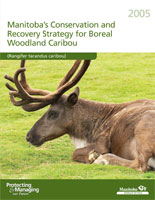 Visit the CDC Manitoba Woodland Caribou Facts web site
Visit the CDC Manitoba Woodland Caribou Facts web site
Manitoba Conservation released another woodland caribou strategy in April 2006. This strategy aims to fulfill requirements for recovery plans, under the federal Species At Risk Act.
 Download Manitoba's Conservation and Recovery Strategy for the Boreal Woodland Caribou (PDF) Download Manitoba's Conservation and Recovery Strategy for the Boreal Woodland Caribou (PDF)
Woodland caribou are also at risk in their boreal ranges in Ontario. Much of Manitoba's east side boreal regions are contiguous with Ontario's intact boreal regions. All of these boreal regions are home to woodland caribou herds.
 Download CPAWS Wildlands League's submission on Recovery Strategy for Forest-dwelling Woodland Caribou in Ontario (PDF) Download CPAWS Wildlands League's submission on Recovery Strategy for Forest-dwelling Woodland Caribou in Ontario (PDF)
 Environment Canada finally released its long-overdue Boreal Caribou Recovery Strategy October 5, 2012. The Caribou Recovery Strategy was required more than five-years ago under Canada's Species At Risk Act (SARA).
Environment Canada finally released its long-overdue Boreal Caribou Recovery Strategy October 5, 2012. The Caribou Recovery Strategy was required more than five-years ago under Canada's Species At Risk Act (SARA).
A July 28, 2011 Federal Court decision forced Kent to revisit his March 2011 decision to refuse emergency protections for woodland caribou in Alberta affected by oil sands development. The Canadian Government was given until September 1, 2011 to implement a draft recovery strategy for woodland caribou.
The Government released an earlier draft Caribou Recovery Strategy August 26, 2011, but the draft was heavily criticized for failing to protect habitat, focusing instead on culling wolf populations and was challenged in the courts for failing to meet the requirement of SARA.
Prodded by a Federal Court direction in July 2012, the federal government set a tentative date for its improved boreal caribou strategy's release of September 30, 2012.
"It is clear that many of the comments provided by Canadian Wildlife Federation on the draft released last year were acted upon. The requirement to maintain a minimum of 65 per cent of critical habitat undisturbed is lower than Canadian Wildlife Federation would like but it sets an important benchmark," said Dr. David Browne, Canadian Wildlife Federation Director of Conservation.
"The habitat protection measures in the strategy only give caribou a 60% chance of long-term survival, which leaves a significant risk that the caribou populations will continue to decline. This falls far short of our recommendation of increasing the target to at least an 80% chance of long-term survival," said Canadian Parks And Wilderness Society National Conservation Biologist Dr. Chris Miller.
"The recovery strategy's focus on the need to conserve habitat is a welcome change, even though it changes nothing on the ground in the short term and temporary population management measures may still be necessary for the most threatened herds," said Simon Dyer of the Pembina Institute, an Alberta based environmental think-tank.
The plan finds that 37 of Canada's woodland caribou herds are in decline. Only 14 are self-sustaining. Previous studies have found almost all the Alberta herds — most of which are in the same region as the oilsands — are very unlikely to survive.
View October 5, 2012 Recovery Strategy for the Woodland Caribou (Rangifer tarandus caribou), Boreal population, in Canada
View October 15, 2012 Pembina Institute blog
View October 5, 2012 Government of Canada press release
View October 5, 2012 Canadian Parks and Wilderness Society press release
View October 5, 2012 CBC News coverage
View October 5, 2012 Prince Albert Now coverage
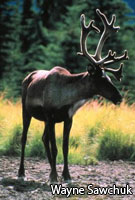 For the second time Canadian Environment Minister Peter Kent has declined to issue an emergency order to protect woodland caribou. Woodland caribou are threatened in Canada largely due to habitat disruption, notably in Alberta's oilsands region where thousands of permits for new wells, mines, roads and pipelines have been issued.
For the second time Canadian Environment Minister Peter Kent has declined to issue an emergency order to protect woodland caribou. Woodland caribou are threatened in Canada largely due to habitat disruption, notably in Alberta's oilsands region where thousands of permits for new wells, mines, roads and pipelines have been issued.
"I have reconsidered and I have determined that nationally, the species does not face an imminent threat to survival at this time," said Kent. The formal reasons for Kent's latest decision have not yet been released.
The Canadian Government was required to revisit the decision not to issue an emergency order to protect woodland caribou, when a July 2011 Federal Court decision found refusal to make the order contradictory with the very same report relied upon to recommend against emergency protection.
The decision also gave the Canadian Government until September 1, 2011 to provide a draft recovery strategy for woodland caribou as required by Species At Risk Act (SARA). Under SARA the draft recovery strategy should have been implemented more that four years before the court decision.
The draft recovery strategy was released August 26, 2011 with a February 22, 2012 deadline for public comments. More than 14,000 submissions resulted. Kent expects the draft recovery strategy to be finalized by April 2012.
Critics of this current draft recovery strategy say it relies too heavily on shooting wolves instead of preserving habitat. They worry the strategy only requires half of Canada's remaining boreal woodland caribou herds to be self-sustaining, and needs of industrial development, particularly in the Alberta oil sands, are coming before the need to protect woodland caribou habitat.
"This is an absurd and deeply unethical strategy that sacrifices both wolves and caribou to unmanaged energy industry growth," said Alberta Wilderness Association conservation specialist Carolyn Campbell.
"The draft strategy requires a 60 per cent chance of persistence when it comes to the survival of the woodland caribou, and for us 60 per cent is not sufficient, we should be aiming closer to 80 per cent," said Éric Hébert-Daly, executive director of the Canadian Parks and Wilderness Society.
"The loss of all the herds in Alberta would have a significant impact on Canada's caribou population nationally because it would fragment the north and western populations from the eastern populations," said Simon Dyer a caribou biologist and Policy Director with the Pembina Institute.
The loss of woodland caribou would also impact First Nations use of herds for traditional sustenance purposes.
"The Dene and the caribou always lived together side by side," said Chief Allan Adam of the Athabasca Chipewyan First Nation. "I think that the minister at this point in time has lost all senses, and in my view I don't think he's credible enough to sit in that position."
View February 21, 2012 Winnipeg Free Press article
View February 16, 2012 Alberta Sweetgrass article
View February 16, 2012 Alberta Wilderness Association article
View February 2012 Sierra Club Canada report (PDF)
View January 29, 2012 CBC article
View January 26, 2012 Ecojustice blog post
View January 25, 2012 Canadian Press article
View Janaury 25, 2012 Ecojustice/Alberta Wilderness Association/Pembina Institute release
View November 4, 2011 Manitoba Wildlands news item
View August 13, 2011 Manitoba Wildlands news item
Sources: Canadian Press, CBC, Winnipeg Free Press
 Feedback and input on draft "Action Plans for Boreal Woodland Caribou Ranges in Manitoba" intended to protect boreal woodland caribou populations in the eastern side of Manitoba can now be provided.
Feedback and input on draft "Action Plans for Boreal Woodland Caribou Ranges in Manitoba" intended to protect boreal woodland caribou populations in the eastern side of Manitoba can now be provided.
"Boreal woodland caribou are a threatened species, and the Owl-Flintstone and Atikaki-Berens caribou populations are particularly vulnerable," said Chomiak. "We've worked with the Eastern Manitoba Woodland Caribou Advisory Committee to develop plans to protect these populations and are now seeking input from the public to make sure these plans are as complete as possible."
The public will have 90 days to comment on the proposal. It is unclear when this 90 period starts or ends, but the announcement was made December 21, 2011.
"It is unclear what the true deadline is. Why is this government beginning a review period in the middle of the holiday season?" asked Manitoba Wildlands Director Gaile Whelan Enns.
Following the public comment period, additional discussion will be initiated with First Nations and other stakeholders. The final action plans will be released by the summer of 2012.
In 2006, Manitoba released a recovery strategy for boreal woodland caribou; it replaced a 2000 recovery strategy for woodland caribou, which is no longer available on the Government of Manitoba webpage.
The 2011 draft action plans for Owl-Flintstone and Atikaki-Berens herds intends to build on the 2006 strategy and outline specific actions the province will take to protect these boreal woodland caribou herds and their habitat.
"As Manitoba has issued new woodland caribou plans the number of herds on the east side has reduced. It maybe time for an independent assessment of our woodland caribou," said Manitoba Wildlands Director Gaile Whelan Enns.
"Action plans for Caribou herds on the west-side of Manitoba are also urgently needed. Forest fires in the summer of 2010, and the proposed west-side Bipole III transmission corridor, among other developments threaten west-side herds, including the at risk NAOSAP herd between Flin Flon and The Pas," added Whelan Enns.
A Canada wide woodland caribou strategy review under the federal Species At Risk Act (SARA) is also underway with public comments due by February 22, 2012.
View December 2011 Draft: Action Plans for Boreal Woodland Caribou Ranges in Manitoba (PDF)
View December 21, 2011 Government of Manitoba press release
View December 21, 2011 Winnipeg Free Press article
View 2006 Government of Manitoba Conservation and Recovery Strategy for Boreal Woodland Caribou (PDF)
View 2000 Government of Manitoba, Woodland Caribou (Rangifer Tarandus Caribou) Conservation Strategy For Manitoba
View August 25, 2010 Manitoba Wildlands news item
Source: Government of Manitoba
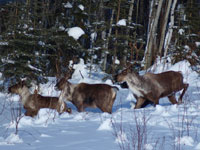 In June 2011 the Pembina Institute went to court with the Alberta Wilderness Association, lawyers from Ecojustice, and three First Nations to argue the Government of Canada had illegally refused to recommend emergency habitat protections for woodland caribou in Alberta. They sought a declaration from the Court that the Minister's refusal to recommend an emergency order for the protection of the woodland caribou herds under the Species at Risk Act is unlawful and unreasonable. Judge Crampton, of Canada's federal court, agreed and gave Canada until September 1, 2001 to release a recovery strategy.
In June 2011 the Pembina Institute went to court with the Alberta Wilderness Association, lawyers from Ecojustice, and three First Nations to argue the Government of Canada had illegally refused to recommend emergency habitat protections for woodland caribou in Alberta. They sought a declaration from the Court that the Minister's refusal to recommend an emergency order for the protection of the woodland caribou herds under the Species at Risk Act is unlawful and unreasonable. Judge Crampton, of Canada's federal court, agreed and gave Canada until September 1, 2001 to release a recovery strategy.
Steps to arrive at a national recovery strategy for woodland caribou, including steps to correct the lack of consultations with Aboriginal Peoples, had already spanned several years. Judge Crampton, of the Federal Court, included in his decision:
"..the Minister clearly erred in reaching his decision by failing to take into account the First Nations Applicants' Treaty Rights and the honour of the Crown in interpreting his mandate ..... The Decision ( Minister Kent's ) therefore warrants being set aside on that basis alone."
Woodland Caribou, Boreal population was listed on Schedule 1 of the Species at Risk Act (SARA) as Threatened in 2003. Under the Species at Risk Act, the federal government is required to prepare a Recovery Strategy. The Recovery Strategy for boreal woodland caribou was due in June 2008, but had been delayed with a revised release date promised for June 2011. Environment Canada has now posted its Recovery Strategy for woodland caribou, with the a comments period until October 25, 2011.
View Canada federal court decision regarding habitat for oil sands woodland caribou
View David Suzuki Foundation boreal woodland caribou page
View April 24, 2009 David Suzuki Foundation article
View July 29, 2011 Pembina Institute blog post
View Environment Canada recovery strategy page
Sources: Suzuki Foundation, Pembina Institute, Federal Court of Canada
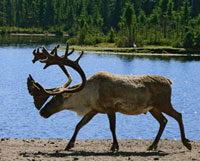 A July 28, 2011 Federal Court decision is forcing Canadian Environment Minister Peter Kent to revisit his March 2011 decision to refuse emergency protections for woodland caribou in Alberta affected by oil sands development. The court found Kent's decision contradictory with the very same report relied upon to recommend against emergency protections.
A July 28, 2011 Federal Court decision is forcing Canadian Environment Minister Peter Kent to revisit his March 2011 decision to refuse emergency protections for woodland caribou in Alberta affected by oil sands development. The court found Kent's decision contradictory with the very same report relied upon to recommend against emergency protections.
Studies, including the ministerial report tendered in court, blame habitat destruction. Forestry has cut nearly 110,000 hectares of habitat — almost three per cent of caribou range. As well, Albertan woodland caribou ranges have about 35,000 oil and gas wells, 66,000 kilometres of seismic lines, 13,000 kilometres of pipelines and 12,000 kilometres of roads.
The lawsuit is an important victory for First Nations applicants.
"This is yet another significant court decision which upholds the treaty rights of First Nations in Canada, and by protecting the caribou herds and caribou habitat, these and other First Nation communities can and will continue to exercise their traditional rights and practices, including hunting, trapping and fishing," said Canadian Assembly of First Nations National Chief Shawn Atleo.
"[T]he Minister clearly erred in reaching his decision by failing to take into account the First Nations Applicants' Treaty Rights and the honour of the Crown," wrote Justice Crampton in his July 28, 2011 decision.
"Given the evidence, and the court's decision, the only reasonable conclusion Minister Kent can come to is that he must recommend emergency protection for the caribou," said Ecojustice staff lawyer Melissa Gorrie.
The Canadian Government now has until September 1, 2011 to implement a draft recovery strategy for woodland caribou (which is already four years late) under the provisions of the Species At Risk Act (SARA), based on the court decision.
Under SARA provinces are required to identify caribou ranges and work within the federal recovery strategy to ensure the survival and recovery of woodland caribou.
Alberta has proposed protected areas as part of a land-use plan for the oilsands region. But critics say the areas aren't in regions most important to caribou and threatened by development.
"Alberta has not... applied appropriate mitigation ... disturbance is beyond the biologically acceptable threshold for self-sustaining local populations as evidenced by the continued decline of most boreal caribou local populations," states the same ministerial report which was relied upon to recommend no action.
The federal recovery strategy could result in a revision of Alberta protection plans.
View Federal Court of Canada decision
View August 4, 2011 Indigenous Peoples Issues & Resources article
View August 9, 2011 Victoria Times Colonist article
View August 3, 2011 Ft. McMurray Today article
View August 3, 2011 HQYellowKnife.com article
View August 2011, Blakes Bulletin on Environmental Law
View July 29th, Eco-justice/Pembina Institute press release
View July 29, Pembina Institute Blog post
View July 29, Canadian Press article
View SARA Public Registry on Woodland Caribou
View David Suzuki Foundation, Boreal Woodland Caribou
Source: Pembina Insitute/Eco-justice
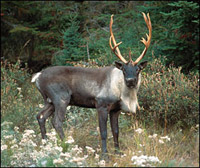 Woodland caribou existence in Canada is threatened by industrial development and piecemeal protection efforts that have not curbed habitat loss. Century-long decreases in woodland caribou populations continue says a new report by the International Boreal Conservation Science Panel.
Woodland caribou existence in Canada is threatened by industrial development and piecemeal protection efforts that have not curbed habitat loss. Century-long decreases in woodland caribou populations continue says a new report by the International Boreal Conservation Science Panel.
The report, Keeping Woodland Caribou in the Boreal Forest, is authored by 23 biologists and other researchers from Canada and the U.S. It was released when Canadian and American environmentalists appealed to Canadian Premiers and Prime Minister Stephen Harper to take action on a political level to prevent extinction of the woodland caribou..
"Their concern is legitimate," said Canadian Environment Minister Peter Kent adding, "in some places the numbers [of woodland caribou] have diminished to the point where regional or sub-regional recovery plans may require fairly drastic protective action."
Caribou were first listed under the Canadian Species At Risk Act (SARA) in 2003. A recovery strategy for woodland caribou is required once the species is listed under SARA. The Canadian government hopes to have a recovery plan in place by the end of the summer 2011. Provinces and Canada need to work together to arrive at recovery strategies that are effective both under federal jurisdiction and in provincial crown lands regions.
Manitoba adopted a Woodland Caribou Conservation Strategy in 2000. That strategy was removed from government web pages before being replaced with a 2005 strategy that reduced the number of woodland caribou herds in Manitoba.
Woodland Caribou were legally protected as threatened under Manitoba's Endangered Species Act (ESA) in 2006. To date habitat for woodland caribou is not protected under the Act. Manitoba needs to update its woodland caribou strategy in a way that truly fulfills the intent to protect the sub species in our boreal regions.
"For caribou to survive and prosper, it will be critical for Manitoba to incorporate state of the art scientific analysis into management planning efforts in the remainder of the boreal forest, particularly in the region of the Tolko Forest Management Agreement," said the Canadian Boreal Initiative (CBI) and Pew Environment Group in a letter to Manitoba Premier Greg Selinger.
"What we need is collaboration between federal, provincial, territorial and aboriginal governments and support from industry and conservation organizations," said Larry Innes, executive director of the CBI.
View July 14, 2011 Ottawa Citizen article
View July 14, 2011 Winnipeg Free Press article
View July 14, 2011 Vancouver Sun article
View July 13, 2011 Globe and Mail article
 Download July 13, 2011 CBI/Pew letter to Greg Selinger (PDF) Download July 13, 2011 CBI/Pew letter to Greg Selinger (PDF)
 Download July 2011 Keeping Woodland Caribou in the Boreal Forest (PDF) Download July 2011 Keeping Woodland Caribou in the Boreal Forest (PDF)
View Species At Risk Publis Registry documents
View June 18, 2011 Manitoba Wildlands Reality Check #14: Does Manitoba Have a Woodland Caribou Recovery Strategy?
Sources: Ottawa Citizen, Canadian Boreal Initiative
 A large forest fire in early summer 2010 burned approximately 55,000 hectares north of Cranberry Portage Manitoba. This fire destroyed a large part of the Kississing-Naosap woodland caribou herd's core range. The herd is considered at high risk by the Manitoba government. Manitoba woodland caribou populations are among those listed as threatened under the Canada Species at Risk Act. The Kississing-Naosap herd is also considered to be at high risk by Manitoba Conservation. A large forest fire in early summer 2010 burned approximately 55,000 hectares north of Cranberry Portage Manitoba. This fire destroyed a large part of the Kississing-Naosap woodland caribou herd's core range. The herd is considered at high risk by the Manitoba government. Manitoba woodland caribou populations are among those listed as threatened under the Canada Species at Risk Act. The Kississing-Naosap herd is also considered to be at high risk by Manitoba Conservation.
Tolko will soon submit its 20 year forest management plan for a more than ten million acre areas that includes the Kississing-Naosap woodland caribou range area affected by the fire. Manitoba Wildlands makes the following recommendations for the management of this woodland caribou population:
- The Manitoba government pause all industrial activity in habitat for this herd ( both burned and not) through the next four caribou activity cycles (fall breeding, winter foraging, spring migration, and summer calving).
- A recovery plan for this herd, based on old and new data and observations be in place for this herd after one year.
- All data regarding woodland caribou in Manitoba be desposited with the Conservation Data Centre.
- Actions to protect woodland caribou habitat for this herd and other Manitoba herds be taken immediately. This includes charges and penalties under Manitoba's Endangered Species Act.
- The Manitoba government conduct a complete provincial woodland caribou census every two years.
More strict guidelines, and audits in place and enforced for industrial development in woodland caribou migratory, foraging, winter, and calving areas.
Manitoba Wildlands is also providing recommendations based on species and boreal science for woodland caribou habitat.
- Maintain or protect areas used year around by woodland caribou, specifically areas with arboreal lichen, spruce trees, and large diameter trees (Metsaranta 2007).
- Maintain or protect areas with mature upland conifer, heavily reed bogs, and jack pine or jack pine/black spruce forests, as well as islands, lakeshores and heavily treed bogs for caribou calving habitat (Darby and Pruitt 1984).
- Maintain or protect wooded lakeshores, and areas containing upland conifer-spruce and treed muskeg for caribou summer post-calving habitat (Metsaranta and Mallory 2007, Malasiuk 1999).
- Maintain or protect areas with mature upland spruce and pine stands and treed muskeg for caribou wintering habitat (Metsaranta and Mallory 2007, Malasiuk 1999).
- Reduce human-related disturbance to areas inhabited by caribou (Landers 2006). At minimum, create 1 to 2 km buffer zones around protected areas within the forest management area to reduce disturbance to the population.
- Reduce or minimize number of open corridors created by forestry operations to reduce predation risk.
- Reduce or minimize alternative prey (eg. Deer and Moose) habitats created through forestry operations.
- Maintain or protect at least 2/3 of winter use zones in large contiguous blocks of high quality winter habitats (Eastern Manitoba Woodland Caribou Advisory Committee Landscape Management Strategy for the Owl Lake Boreal Woodland Caribou Herd, 2005).
- Maintain the areas protected for woodland caribou use in large contiguous blocks.
- Maintain undisturbed travel corridors between wintering/calving/rutting areas to allow for movement of caribou between seasonal/ foraging grounds.
View August 25, 2010 Manitoba Wildlands news item
 Boreal Woodland Caribou were listed as threatened under Canada's Species at Risk Act (SARA) in 2003. Environment Canada was tasked with developing a national recovery strategy for boreal caribou. A second round to arrive at this recovery plan includes ensuring Aboriginal traditional knowledge about boreal caribou informs the recovery strategy, and conducting science studies on boreal caribou habitat needs. The proposed national recovery strategy will be posted on the Species at Risk Public Registry in the summer of 2011. Public review will be conducted online for the stages of this national strategy. Boreal Woodland Caribou were listed as threatened under Canada's Species at Risk Act (SARA) in 2003. Environment Canada was tasked with developing a national recovery strategy for boreal caribou. A second round to arrive at this recovery plan includes ensuring Aboriginal traditional knowledge about boreal caribou informs the recovery strategy, and conducting science studies on boreal caribou habitat needs. The proposed national recovery strategy will be posted on the Species at Risk Public Registry in the summer of 2011. Public review will be conducted online for the stages of this national strategy.
View Environment Canada woodland caribou consultation and scientific documents
 The British Columbia (B.C.) Court of Appeal has ruled that the provincial government didn't properly consult with First Nations when it allowed a coal company to begin exploration in northeastern B.C.
The British Columbia (B.C.) Court of Appeal has ruled that the provincial government didn't properly consult with First Nations when it allowed a coal company to begin exploration in northeastern B.C.
In September 2009, officials from the Ministry of Energy, Mines and Petroleum Resources amended existing permits to allow First Coal Corporation to obtain a 50,000 tonne bulk sample of coal and to engage in a 173-drill-hole, five-trench advanced exploration program.
The West Moberly First Nations asserted that coal exploration would destroy critical winter habitat for the endangered Burnt Pine caribou herd, and the decisions were made without consideration of their right to hunt the caribou and without making adequate provision for protection and restoration of the herd. There are only 11 caribou left in the herd and West Moberly elders have banned hunting of the animals since 1970s.
In his written decision for the majority, Chief Justice Lance Finch affirmed the ruling that the Crown failed to consult "adequately and meaningfully" and failed to accommodate the petitioners' treaty hunting rights.
"Now that the court has affirmed the government's duty, we look forward to working co-operatively in the coming weeks and months to do what it takes to save this species from extinction," said West Moberly Chief Roland Willson
View May 27, 2011, Vancouver Sun article
View May 26, 2011, The Province article
View May 26, 2011, CBC News article
View May 25, 2011 Marketwire article
View May 25, 2011 BC Court of Appeal decision
Source:
The Province
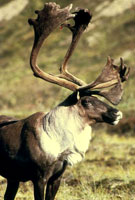 On July 15th, 2010, four Alberta First Nations communities - Beaver Lake Cree Nation, Enoch Cree Nation, Chipewyan Prairie Dene First Nation and Athabasca Chipewyan First Nation - have called on Canada's Minister of the Environment to issue an emergency order to protect the Woodland Caribou in Alberta from further industrial development. On July 15th, 2010, four Alberta First Nations communities - Beaver Lake Cree Nation, Enoch Cree Nation, Chipewyan Prairie Dene First Nation and Athabasca Chipewyan First Nation - have called on Canada's Minister of the Environment to issue an emergency order to protect the Woodland Caribou in Alberta from further industrial development.
The coalition of First Nations states the situation is dire. The government of Canada failed to issue a recovery plan for Woodland Caribou by it's own mandated deadline of three years ago, and most of Alberta's Woodland Caribou populations are in decline.
Recent research showing two specific caribou groups face extinction within 10 to 15 years time prompted a coalition of four First Nations to urge Jim Prentice and Environment Canada to take immediate action to protect the caribou, or else face legal action.
The letter, produced by Woodward and Co, to Environment Minister Prentice states:
"... You have 45 days from the date of this letter to comply with your mandatory statutory duties under s. 80(2) of the Species at Risk Act, by recommending to the federal Cabinet that it make an emergency order to protect woodland caribou and their habitat from any further industrial development in the full ranges of the remaining herds in northeastern Alberta (or in a wider area)."
Should Environment Canada fail to issue the emergency protection, the First Nations will seek a court order forcing the Canadian government to protect the endangered Woodland Caribou.
After identifying the caribou as being endangered, Environment Canada was required under its own Species at Risk Act, to have prepared a recovery plan by 2007. The government is still consulting the public, a process that will end August 31, 2010. The government plans to issue a recovery plan for public review by summer 2011.
The latest research by Dr. Stab Boutin has prompted action from the four communities, because it shows two specific herds of caribou have decreased in size by over 70% in the past 14 years.
Dr. Boutin states the steep decline in herd population is a result of "... the cumulative effects of rampant industrial development on caribou habitat, particularly by the oil and gas industry." Boutin has recommended that the full range of the caribou be protected from encroachment and restoring habitat.
"We are calling on government to immediately halt the destruction of our lands, lands that sustain our caribou and our people. It is difficult for me to express the anger I feel at the loss of this noble animal in our territory. Our traditional land is dwindling. We need habitat for our animals to ensure there is a healthy surplus. These animals sustain us and, as they die, our future becomes uncertain. We must act now to take care of Mother Earth," states Al Lameman, Chief of the Beaver Lake Cree Nation.
 Download July 15, 2010 Letter to Jim Prentice regarding petition for emergency order to protect woodland caribou (PDF) Download July 15, 2010 Letter to Jim Prentice regarding petition for emergency order to protect woodland caribou (PDF)
 Download July 5th, 2010 Dr. Stan Boutin's report (PDF) Download July 5th, 2010 Dr. Stan Boutin's report (PDF)
View July 17th, 2010 Indigenous Peoples article
View July 18th, 2010 Digital Journal article
View July 26, 2010 CBC News article
Source: Digital Journal
Evaluation of Manitoba's Conservation and Recovery
Strategy for Boreal Woodland Caribou
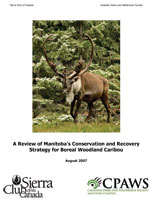 An August 2007 study by the Sierra Club of Canada and the Canadian Parks and Wilderness Society (CPAWS) says that although the Manitoba government has the right goals to recover its threatened boreal woodland caribou, action on those goals is emphatically lacking.
An August 2007 study by the Sierra Club of Canada and the Canadian Parks and Wilderness Society (CPAWS) says that although the Manitoba government has the right goals to recover its threatened boreal woodland caribou, action on those goals is emphatically lacking.
The conservation groups commissioned an evaluation of Manitoba's Conservation and Recovery Strategy for Boreal Woodland Caribou to assess the degree to which it fulfills the obligations of federal Species At Risk legislation, such as critical habitat identification and adequate identification of strategies for mitigating threats to habitat.
The evaluation found that Manitoba's Strategy has three fundamental deficiencies:
- critical habitat is not identified
- there is no plan to aggressively protect habitat by establishing new parks and protected areas
- recovery action in Manitoba does not reflect the urgency of the situation faced by woodland caribou
 Download August 2007 Sierra Club of Canada and CPAWS Manitoba publication, A Review of Manitoba's Conservation and Recovery Strategy for Boreal Woodland Caribou (PDF) Download August 2007 Sierra Club of Canada and CPAWS Manitoba publication, A Review of Manitoba's Conservation and Recovery Strategy for Boreal Woodland Caribou (PDF)
Sources: Sierra Club of Canada, CPAWS Manitoba
Manitoba's Arctic Caribou
The Beverly and Qamanirjuaq Caribou Management Board released its September 2004 position paper: Protecting Calving Grounds, Post-Calving Areas and Other Important Habitats for Beverly and Qamanirjuaq Caribou. Manitoba sits on this caribou management board, and the map provided here shows the significant winter range areas in Manitoba used by the Qamanirjuaq barren-ground caribou herd. The discussion paper provides a set of principles and recommendations for action to safeguard the future of these herds, with responsibility resting on all the jurisdictions where range is used.
|
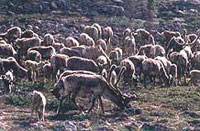 The Canadian Northwest Territories government has stated that the 2007 and 2008 reconnaissance surveys at the peak of calving season shows the Beverly caribou numbers have sharply dropped. The Canadian Northwest Territories government has stated that the 2007 and 2008 reconnaissance surveys at the peak of calving season shows the Beverly caribou numbers have sharply dropped.
During the 2007 survey, only 189 adult female caribou were counted on the Beverly calving ground and only 93 cows were seen during June 2008 survey. This is a sharp decrease from 5,737 cows seen in 1994.
"Caribou-wise, it was very depressing," says Beverly and Qamanirjuaq Caribou Management Board (BQCMB) member Dennis Larocque. Outside the calving ground, Larocque saw only one caribou and almost no caribou tracks.
A mix of factors may be to blame for the population drop, such as mineral exploration and development, hunter harvest, changes in habitat (including winter range being lost to forest fires), parasites and diseases, predation and climate change.
The main factors identified in the Beverly caribou herd recovery are protecting calving grounds, obtaining accurate harvest statistics, reducing wastage, encouraging hunters to select bulls over cows, and ensuring the Beverly herd, as well as neighbouring herds, continue to be monitored.
Five other North West Territories barren-ground caribou herds (Porcupine, Cape Bathurst, Bluenose West, Bluenose East, and Bathurst) have also recently seen declines.
The BQCMB is currently urging governments to implement the Beverly and Qamanirjuaq Caribou Management Plan (2005-2012). As well, the BQCMB is proposing a Beverly and Qamanirjuaq stakeholders workshop in February 2010 for representatives organizations and communities so they can assess the action plan and provide input.
View Summer 2009 Beverly and Qamanirjuaq Caribou Management Board newsletter
View July 2009 The Beverly and Qamanirjuaq Caribou Management Board press release
Source: Caribou News in Brief, The Beverly and Qamanirjuaq Caribou Management Board
Caribou - Journal of Wildlife Management
According to a new study conducted by Liv Vors at Trent University and the Ontario Ministry of Natural Resources, woodland caribou face an uncertain future in boreal forests due to human activity.
The researchers found a strong connection between the disappearance of woodland caribou across northern Ontario and human-caused habitat changes, including forestry cutovers, railroads, utility lines, roads, and trails. Woodland caribou were less likely to be present near these types of disturbances. The species was predictably absent within 13 kilometres of a forestry cutover - a distance much greater than currently considered in caribou management guidelines. The study also says there is no evidence that caribou have ever returned to a cutover area after trees have regrown.
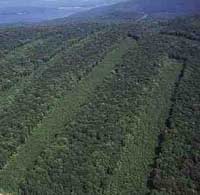 The study indicates caribou need a median range of 9,000 square kilometres of undisturbed habitat, surrounded by a 13-kilometre buffer zone, to maintain local populations.
The study indicates caribou need a median range of 9,000 square kilometres of undisturbed habitat, surrounded by a 13-kilometre buffer zone, to maintain local populations.
The study also uncovered evidence of an "extinction debt" - a delay between habitat loss and disappearance of a species. For woodland caribou, an extinction debt of 20 years was supported by the pattern of cutovers in 1970 that accurately predicted the presence and absence of caribou two decades later.
View September 1, 2007 Toronto Star article
View July 31, 2007 Trent University press release
 Download June 2007 Journal of Wildlife Management article, Woodland Caribou Extirpation and Anthropogenic Landscape Disturbance in Ontario (PDF) Download June 2007 Journal of Wildlife Management article, Woodland Caribou Extirpation and Anthropogenic Landscape Disturbance in Ontario (PDF)
Sources: Toronto Star, Trent University
Federal Review of Boreal Woodland Caribou
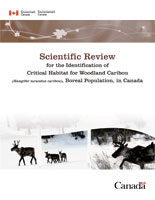 In April 2009, Environment Canada released their science-based review, the Identification of Critical Habitat for Woodland Caribou (Rangifer tarandus caribou), Boreal Population, in Canada, as required under the federal Species at Risk Act (SARA). In April 2009, Environment Canada released their science-based review, the Identification of Critical Habitat for Woodland Caribou (Rangifer tarandus caribou), Boreal Population, in Canada, as required under the federal Species at Risk Act (SARA).
The report indicates that woodland caribou are in worse trouble than previously thought and unless Canada adopts a new approach to protecting caribou habitat, caribou will become extinct by the end of this century. The report describes methods for identifying critical habitat necessary for the recovery of viable populations of woodland caribou.
The study concludes 29 of the 57 remaining herds of boreal caribou are not self-sustaining. Several herds are at risk in northern Alberta and Saskatchewan, where logging, mining and energy development has grown in the last decade.
View SARA report, Scientific Review for the Identification of Critical Habitat for Woodland Caribou, Boreal Population in Canada (see public comments option)
View April 9, 2009 CPAWS article
View April 9, 2009 Boreal Canada article
Visit Caribou and You, CPAWS
Sources: Government of Canada |

 Manitoba is the home to as many as 20 woodland caribou herds. The Manitoba government has determined the geographic ranges, calving sites and winter ranges for these herds, plus the current degree of risk for each herd in a range. Every environmental license area for forestry operations in Manitoba includes specific woodland caribou ranges. Woodland caribou are listed as endangered by COSEWIC through eastern Canada, and are listed as threatened in Manitoba.
Manitoba is the home to as many as 20 woodland caribou herds. The Manitoba government has determined the geographic ranges, calving sites and winter ranges for these herds, plus the current degree of risk for each herd in a range. Every environmental license area for forestry operations in Manitoba includes specific woodland caribou ranges. Woodland caribou are listed as endangered by COSEWIC through eastern Canada, and are listed as threatened in Manitoba. Visit the CDC Manitoba Woodland Caribou Facts web site
Visit the CDC Manitoba Woodland Caribou Facts web site  Download Manitoba's Conservation and Recovery Strategy for the Boreal Woodland Caribou (PDF)
Download Manitoba's Conservation and Recovery Strategy for the Boreal Woodland Caribou (PDF) Download CPAWS Wildlands League's submission on Recovery Strategy for Forest-dwelling Woodland Caribou in Ontario (PDF)
Download CPAWS Wildlands League's submission on Recovery Strategy for Forest-dwelling Woodland Caribou in Ontario (PDF) Environment Canada finally released its long-overdue Boreal Caribou Recovery Strategy October 5, 2012. The Caribou Recovery Strategy was required more than five-years ago under Canada's Species At Risk Act (SARA).
Environment Canada finally released its long-overdue Boreal Caribou Recovery Strategy October 5, 2012. The Caribou Recovery Strategy was required more than five-years ago under Canada's Species At Risk Act (SARA). For the second time Canadian Environment Minister Peter Kent has declined to issue an emergency order to protect woodland caribou. Woodland caribou are threatened in Canada largely due to habitat disruption, notably in Alberta's oilsands region where thousands of permits for new wells, mines, roads and pipelines have been issued.
For the second time Canadian Environment Minister Peter Kent has declined to issue an emergency order to protect woodland caribou. Woodland caribou are threatened in Canada largely due to habitat disruption, notably in Alberta's oilsands region where thousands of permits for new wells, mines, roads and pipelines have been issued. Feedback and input on draft "Action Plans for Boreal Woodland Caribou Ranges in Manitoba" intended to protect boreal woodland caribou populations in the eastern side of Manitoba can now be provided.
Feedback and input on draft "Action Plans for Boreal Woodland Caribou Ranges in Manitoba" intended to protect boreal woodland caribou populations in the eastern side of Manitoba can now be provided. Download BQCMB Position Paper: Protecting Beverly and Qamanirjuaq Caribou (PDF)
Download BQCMB Position Paper: Protecting Beverly and Qamanirjuaq Caribou (PDF) Download Map of the Winter Range of Beverly and Qamanirjuaq Caribou (PDF)
Download Map of the Winter Range of Beverly and Qamanirjuaq Caribou (PDF)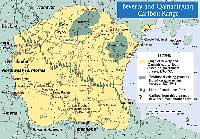
 The Canadian Northwest Territories government has stated that the 2007 and 2008 reconnaissance surveys at the peak of calving season shows the Beverly caribou numbers have sharply dropped.
The Canadian Northwest Territories government has stated that the 2007 and 2008 reconnaissance surveys at the peak of calving season shows the Beverly caribou numbers have sharply dropped.
 The study indicates caribou need a median range of 9,000 square kilometres of undisturbed habitat, surrounded by a 13-kilometre buffer zone, to maintain local populations.
The study indicates caribou need a median range of 9,000 square kilometres of undisturbed habitat, surrounded by a 13-kilometre buffer zone, to maintain local populations. Download June 2007 Journal of Wildlife Management article, Woodland Caribou Extirpation and Anthropogenic Landscape Disturbance in Ontario (PDF)
Download June 2007 Journal of Wildlife Management article, Woodland Caribou Extirpation and Anthropogenic Landscape Disturbance in Ontario (PDF) In April 2009, Environment Canada released their science-based review, the Identification of Critical Habitat for Woodland Caribou (Rangifer tarandus caribou), Boreal Population, in Canada, as required under the federal Species at Risk Act (SARA).
In April 2009, Environment Canada released their science-based review, the Identification of Critical Habitat for Woodland Caribou (Rangifer tarandus caribou), Boreal Population, in Canada, as required under the federal Species at Risk Act (SARA). 2002-2014
2002-2014



 In June 2011 the Pembina Institute went to court with the Alberta Wilderness Association, lawyers from Ecojustice, and three First Nations to argue the Government of Canada had illegally refused to recommend emergency habitat protections for woodland caribou in Alberta. They sought a declaration from the Court that the Minister's refusal to recommend an emergency order for the protection of the woodland caribou herds under the Species at Risk Act is unlawful and unreasonable. Judge Crampton, of Canada's federal court, agreed and gave Canada until September 1, 2001 to release a recovery strategy.
In June 2011 the Pembina Institute went to court with the Alberta Wilderness Association, lawyers from Ecojustice, and three First Nations to argue the Government of Canada had illegally refused to recommend emergency habitat protections for woodland caribou in Alberta. They sought a declaration from the Court that the Minister's refusal to recommend an emergency order for the protection of the woodland caribou herds under the Species at Risk Act is unlawful and unreasonable. Judge Crampton, of Canada's federal court, agreed and gave Canada until September 1, 2001 to release a recovery strategy. A July 28, 2011 Federal Court decision is forcing Canadian Environment Minister Peter Kent to revisit his March 2011 decision to refuse emergency protections for woodland caribou in Alberta affected by oil sands development. The court found Kent's decision contradictory with the very same report relied upon to recommend against emergency protections.
A July 28, 2011 Federal Court decision is forcing Canadian Environment Minister Peter Kent to revisit his March 2011 decision to refuse emergency protections for woodland caribou in Alberta affected by oil sands development. The court found Kent's decision contradictory with the very same report relied upon to recommend against emergency protections. Woodland caribou existence in Canada is threatened by industrial development and piecemeal protection efforts that have not curbed habitat loss. Century-long decreases in woodland caribou populations continue says a new report by the International Boreal Conservation Science Panel.
Woodland caribou existence in Canada is threatened by industrial development and piecemeal protection efforts that have not curbed habitat loss. Century-long decreases in woodland caribou populations continue says a new report by the International Boreal Conservation Science Panel. Boreal Woodland Caribou were listed as threatened under Canada's Species at Risk Act (SARA) in 2003. Environment Canada was tasked with developing a national recovery strategy for boreal caribou. A second round to arrive at this recovery plan includes ensuring Aboriginal traditional knowledge about boreal caribou informs the recovery strategy, and conducting science studies on boreal caribou habitat needs. The proposed national recovery strategy will be posted on the Species at Risk Public Registry in the summer of 2011. Public review will be conducted online for the stages of this national strategy.
Boreal Woodland Caribou were listed as threatened under Canada's Species at Risk Act (SARA) in 2003. Environment Canada was tasked with developing a national recovery strategy for boreal caribou. A second round to arrive at this recovery plan includes ensuring Aboriginal traditional knowledge about boreal caribou informs the recovery strategy, and conducting science studies on boreal caribou habitat needs. The proposed national recovery strategy will be posted on the Species at Risk Public Registry in the summer of 2011. Public review will be conducted online for the stages of this national strategy. The British Columbia (B.C.) Court of Appeal has ruled that the provincial government didn't properly consult with First Nations when it allowed a coal company to begin exploration in northeastern B.C.
The British Columbia (B.C.) Court of Appeal has ruled that the provincial government didn't properly consult with First Nations when it allowed a coal company to begin exploration in northeastern B.C. On July 15th, 2010, four Alberta First Nations communities - Beaver Lake Cree Nation, Enoch Cree Nation, Chipewyan Prairie Dene First Nation and Athabasca Chipewyan First Nation - have called on Canada's Minister of the Environment to issue an emergency order to protect the Woodland Caribou in Alberta from further industrial development.
On July 15th, 2010, four Alberta First Nations communities - Beaver Lake Cree Nation, Enoch Cree Nation, Chipewyan Prairie Dene First Nation and Athabasca Chipewyan First Nation - have called on Canada's Minister of the Environment to issue an emergency order to protect the Woodland Caribou in Alberta from further industrial development. An August 2007 study by the Sierra Club of Canada and the Canadian Parks and Wilderness Society (CPAWS) says that although the Manitoba government has the right goals to recover its threatened boreal woodland caribou, action on those goals is emphatically lacking.
An August 2007 study by the Sierra Club of Canada and the Canadian Parks and Wilderness Society (CPAWS) says that although the Manitoba government has the right goals to recover its threatened boreal woodland caribou, action on those goals is emphatically lacking.